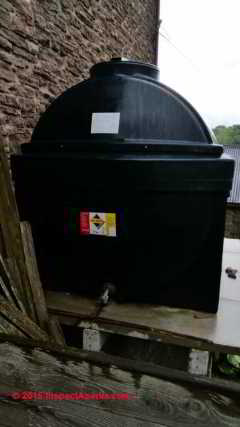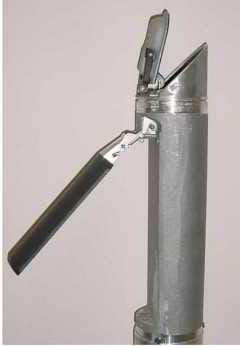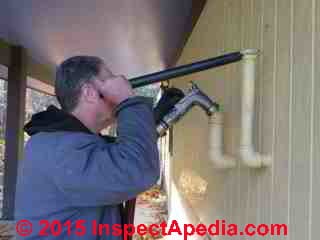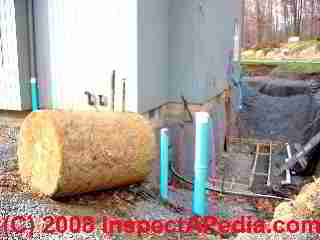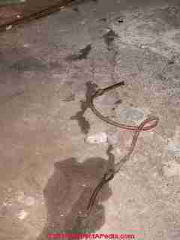 Heating Oil Spill Cleanup, Remediation, & Prevention
Heating Oil Spill Cleanup, Remediation, & Prevention
- POST a QUESTION or COMMENT about oil tank leaks, spills, and leak cleanup
Heating oil spill guide for homeowners:
Heating Oil Spill Guide for Homes & Light-Commercial Buildings. This article describes an approach to prevention of above ground or buried oil tank leaks or leaks anywhere in the heating oil tank and piping and burner system.
We include lists oil spill cleanup and prevention experts, supplies, training resources, regulations, and technical information.
This oil tank leak and leak prevention article series answers nearly all questions about above ground or buried oil storage tanks including oil tank installation, abandonment, removal, leak testing, leak prevention, and regulations.
InspectAPedia tolerates no conflicts of interest. We have no relationship with advertisers, products, or services discussed at this website.
- Daniel Friedman, Publisher/Editor/Author - See WHO ARE WE?
Heating Oil Leak & Spill Prevention Recommendations
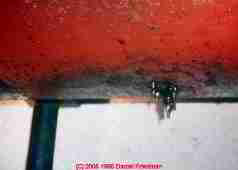 Proper installation, inspection, & maintenance of heating oil storage tanks, piping, valves, & controls are the key measures that can prevent both small leaks that lead to heating system operating troubles (or loss of heat or dangerous puffbacks) and larger leaks that lead to costly oil spill cleanup jobs.
Proper installation, inspection, & maintenance of heating oil storage tanks, piping, valves, & controls are the key measures that can prevent both small leaks that lead to heating system operating troubles (or loss of heat or dangerous puffbacks) and larger leaks that lead to costly oil spill cleanup jobs.
Here are links to greater depths on the key topics that should be part of a residential or commercial oil leak & spill prevention program:
- At OIL TANK LEAK / FAILURE CAUSES we describe the common sources of oil tank damage, leaks, or water entry.
We also provide data on OIL TANK LEAK / FAILURE RATES. - ABOVE GROUND OIL TANK (AST) GUIDE and
also OIL TANK INSPECTION & TROUBLESHOOTING contain suggestions for problems that can alert you to a problem with the oil tank that can contribute to leaks or equipment operating trouble. Above ground oil tanks can also be tested for corrosion, steel thickness (if it's a steel tank) and other defects.
See OIL TANK LEAKS & SMELLS and
and also OIL TANK TEST ADVICE. - BURIED OIL TANK (UST) GUIDE - proper installation of the oil tank, for purposes of spill or leak prevention means using the right kind of tank, locating it properly, avoiding damaging the oil tank during transport or installation, knowing soil conditions (soil chemistry can contribute to oil tank corrosion), and periodic tank inspections for water or other trouble signs.
When there is a reason for extra concern, such as oil tank age, unknown condition, or discovery of loss of oil or water in oil, the tank should be tested.
See OIL TANK TEST ADVICE. - OIL TANK PIPING & PIPING DEFECTS describes oil piping, controls, valves, and equipment inspection & maintenance: as we noted, small leaks mean heating equipment operating problems or even loss of heat while a larger leak means an expensive cleanup job.
Oil line safety and fire safety valves include features that can prevent a leak of heating oil from the oil piping, fittings, & controls between the oil tank and the oil burner.
See OIL SUPPLY LINE SAFETY VALVES, OSVs.
- OIL SPILL PREVENTION & DETECTION DEVICES - see Prevent Oil Spills from Over-Filling or Detect Tank Leaks below
Prevent Oil Spills from Over-Filling or Detect Tank Leaks: Using a SpillStop type / drop tube shutoff valve
Shown above is an outdoor, above-ground, weatherproof plastic oil storage tank. This tank is installed at a farm in St. Weonards in Herefordshire in the U.K. And yes you can protect a steel above ground oil storage tank from rust damage. As an added guard against oil spills from over-filling, this AST is equipped with a SpillStop automatic overflow prevention valve.
The SpillStop and similar valves are designed to allow no more than filling to 95% of the il tank's capacity - varying a bit by spillstop and tank make and model. Sonic alarms and other over-fill and oil spill or leak detection devices are available. The "SpillStop" name appears on more than one oil spill prevention product. A similar device used in the U.S. is the drop tube shutoff valve shown atabelow.
Excerpting from oil spill prevention guidelines offered by the North Dakota U.S. T. operator training program,
The drop tube shutoff valve is a mechanical device installed in line with the drop tube. A drop tube is a thin aluminum tube located inside the tank fill-pipe riser that extends close to the bottom of the tank. The drop tube minimizes vapors created during a fuel delivery.
Typically, there is a float-activated mechanism on the outside of the drop tube that releases a valve, or flapper, inside the drop tube when the liquid level in the tank reaches 95% of full-tank capacity. The shutoff valve should be positioned so that the float arm is not obstructed and can move through its full range of motion.
When the shutoff valve is released, the product flowing down the fill pipe slams it shut, severely restricting the flow of fuel into the tank. The delivery hose “jumps” when the flapper closes, alerting the transport driver that the tank is nearly full. The driver should immediately close the delivery valve, and drain any remaining fuel in the hose into the tank.
To notice the hose “jump,” the delivery driver must watch the delivery hose, not sit inside the truck or building. - North Dakota, Spill and Overfill Control, cited below.
Watch out: the same program training materials contain warnings about what can go wrong with a SpillStop type valve including stresses on the oil piping and delivery system that could lead to leaks or spills.
Drop tube shutoff valves work well as long as they are used and maintained properly. There are several potential problems with drop tube shutoff valves to consider:
Drop tube devices must not be disabled or bypassed. A gauge stick in a fill pipe prevents the drop tube shutoff valve from closing. If a gauge stick is discovered in a fill pipe, it should be removed and a service technician called to inspect the overfill valve and ensure it operates properly.
The sudden closing of the drop tube valve transmits considerable stress to the delivery system. The hose connections to the tank and truck must be secure or they may pop off, creating a significant surface spill.
There must be a tight-fill connection between the tank and the delivery hose.
Deliveries must be made by gravity only. If a delivery is made under pressure (pumped) and the shutoff valve activates, something is likely to break. - North Dakota, Spill and Overfill Control, cited below.
Oil Spill Prevention & Oil Spill or Leak Detection Devices & Methods for USTs and ASTs
- Brains: the oil delivery driver shown in our photo above is using an ABS pipe tube to listen to air escaping at the oil tank vent pipe. This oil tank has no working vent alarm nor any other signaling device. The driver listens for the change in sound as the oil reaches the top of the oil tank and stops the delivery.
The brains approach requires more than brains, also effort and tolerance of standing in cold weather listening to an oil tank vent pipe. This driver, working with Bottini Oil in Poughkeepsie NY is a thoughtful one. - OIL TANK LIFE EXTENSION - steps to maximize oil storage tank life by proper installation, piping, and maintenance. These steps also reduce the chances of a leak at the oil tank or its piping.
- Vent Alarms: mechanical oil tank fill alarms: popularly, the oil tank whistle is a ball and float type valve installed at the air vent.
When the level of oil in the tank reaches the bottom of the float valve, he delivery person hears the cessation of the whistling sound produced by air being vented from the oil tank during filling.
See OIL TANK FILL & VENT PIPING INSPECTION CHECKLISTfor a description of oil tank vent alarms. - Electronic alarms: electronic alarms are available to signal when the oil tank is filled to a specified level to prevent over filling and spillage. Overfill-alarms are installed to sound an alarm and flash a light when the tank is filled up to 90%. Electronic overfill alarms are typically connected to an electronic oil storage tank level gauge.
Watch out: an alarm will signal when the delivery driver should prepare to stop filling the oil tank but unlike the SpillStop or drop float valve, it won't by itself physically stop the delivery of oil. - Oil Deliver Driver Training: e.g. North Dakota, U.S., "Spill and Overfill Control" [PDF] provided by the North Dakota UST Operator Training PRogram, Website: https://secure.apps.nd.gov/doh/operator/training/operatortraining_spill.pdf
This document describes steps that the oil delivery driver shall take to avoid oil spills or over-fills and it also describes devices similar to the SpillStop discussed below. - retrieved 2015/11/10 - Drop Tube Shutoff Valve or SpillStop Automatic overfill prevention valve, Kingspan Environmental, including offices throughout Europe.
Kingspan provides other oil control and spill prevention or detection devices including SonicSignalman, WatchmanAlarm, and WatchmanSonic. In the U.K. contact:- United Kingdom Kingspan Environmental Ltd College Road North, Aston Clinton Aylesbury, Buckinghamshire HP22 5EW United Kingdom Tel: +44 (0) 1296 633000 Fax: +44 (0) 1296 6330
- Ireland Kingspan Environmental Ltd 180 Gilford Road Portadown, Co Armagh BT63 5LE, Northern Ireland T: +44 28 3836 4400 F: +44 28 3836 4445
- Kingspan Environmental Avda. Europa, 9 08769 Castellví de Rosanes Barcelona, Spain T: +34 936 620 525 F: +34 936 389 793 info@kingspan-env.es
Oil Tank Leak Testing & Oil Leak/Spill Cleanup Companies Listing
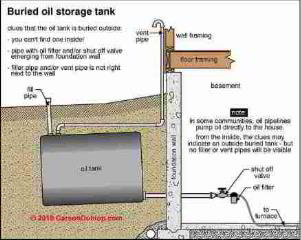 Indoor oil spills during tank fill or later from a leaky oil tank range from trivial
local cleanup and deodorizing efforts to very serious contamination problems if an oil tank bursts
during oil delivery (which we suspect is rare) and on occasions when an indoor oil tank has been
removed but someone (some fool) has left the oil filler pipe installed on the building, and when
subsequently an oil delivery is mistakenly made through the filler pipe onto the empty basement
or crawl space floor.
Indoor oil spills during tank fill or later from a leaky oil tank range from trivial
local cleanup and deodorizing efforts to very serious contamination problems if an oil tank bursts
during oil delivery (which we suspect is rare) and on occasions when an indoor oil tank has been
removed but someone (some fool) has left the oil filler pipe installed on the building, and when
subsequently an oil delivery is mistakenly made through the filler pipe onto the empty basement
or crawl space floor.
This may sound crazy but it actually happens.
At OIL TANK ABANDONING PROCEDURE we discuss steps a building owner should take to be darn sure that oil is not accidentally pumped into the building or into an abandoned oil tank.
Sketch courtesy of Carson Dunlop Associates, a Toronto home inspection, education & report writing tool company [ carsondunlop.com ].
Outdoor and buried oil tank oil spills occur due to a variety of causes.
In-Tank corrosion of oil storage tanks: Underground fuel or heating oil storage tanks usually fail from rust perforation due to several effects of water inside the tank including, in the case of heating oil, combination of water with sulphur in the fuel, bacterial action, and other factors.
External rust on oil tanks, unless very heavy, isn't highly correlated with internal rust. Leaks can occur due to tank damage or at piping connections.
Oil Tanks in Corrosive Soils: Oil storage tank leaks are more likely if a steel tank has been buried in corrosive soil or if the tank was damaged during installation, such as gouging it or bouncing it off of a rock as it was placed into a hole for burying.
Oil Tank Piping Leaks: Oil tank leaks may occur at buried piping connections as well.
Delivery Oil Spills: occur around the tank fill pipe and range from trivial to more extensive requiring soil removal and cleaning. These leaks are usually obvious at the ground surface around the oil tank or tank filler.
Inadequate fill or vent pipe diameter is blamed by some for leaks at buried or above ground oil tanks, asserting that because oil tanks are filled under pressure from the oil delivery pumper-truck, a corroded, damaged, or poorly-plumbed oil storage tank, or one with a too-small vent opening, may not withstand the pressure of the filling process.
TESTING COs / REMOVAL COs - Oil Tank Testing, Removal, Consulting Environmental Service Companies
Heating Oil Spill Cleanup:
For details on cleaning up residential oil spills see OIL TANK LEAK CLEANUP GUIDE. Also see OIL TANK TESTING COs
and OIL TANK REMOVAL FINANCIAL AID links here or at the ARTICLE INDEX the bottom of this article to see our most current list of companies providing oil tank testing or oil tank removal/abandonment services.
- ABOVE GROUND OIL TANK (AST) GUIDE - inspect oil tanks to notice and correct problems before a costly oil spill occurs in your building
- BURIED OIL TANK (UST) GUIDE - recommendations for evaluating the condition of underground oil storage tanks, leak prevention, leak testing
Heating Oil Tank Testing or Removal
- OIL TANK REMOVAL COs lists companies providing oil storage tank location, inspection, and testing for leaks and who also will perform oil tank abandonment in-place, or oil tank removal. Also see OIL TANK REMOVAL FINANCIAL AID
- OIL TANK TESTING & REMOVAL COs lists companies providing oil storage tank location, inspection, and testing for leaks
- ATTORNEYS and EXPERT WITNESSES includes environmental experts
- FLOATING UP OIL STORAGE or SEPTIC TANKS - a light-weight and nearly-empty buried oil tank may float up from underground during periods of flooding, tearing oil piping and causing an oil spill.
- OIL, HEATING, EXPOSURE HAZARDS, LIMITS what are the health hazards from exposure to No.2 home heating oil (and automotive deisel fuel)?
- HEATING OIL EXPOSURE HAZARDS, LIMITS
- MSDS MATERIAL SAFETY DATA SHEETS - of specific interest to InspectAPedia readers
Oil Spill Secondary Containment and Oil Spill Remediation Products, Services, Advice, Training
- Oil Spill Secondary Containment and Oil Spill Remediation
- Bioremediation resources on Internet
- Environmental and Information Resources, Inc. markets a low cost way of cleaning up petroleum hydrocarbon releases called bioremediation using naturally occurring soil microbes. EIR also performs biologically based cleanups of inorganic contamination such as heavy metals and radio nuclides using phytoremediation to uptake contamination from soil or groundwater.
- Spill-911 company provides oil spill containment and prevention supplies - 800-474-5911 - how to prevent oil tank leaks and oil spills from spreading by using secondary containment. Oil Spill Containment items provide storage, secondary containment, protection and response to minimize the impact of leaks and spills. Poly and Steel Drums, Containment Berms and Spill Containment Decks and Spill Pallets.
- OIL TANK LEAK CLEANUP GUIDE - detailed cleanup advice for residential oil tank leaks and spills
- OIL TANK LEAK / FAILURE CAUSES and OIL TANK LEAK / FAILURE RATES give insight into the risk of an oil tank leak or spill at your property.
- The rate or frequency of oil tank leaks or oil storage tank failures, focused on underground storage tanks or USTs,
is discussed in detail at TANK FAILURE RATES provides Oil Tank Failure Data - Oil Tank Failure Rates
-
Oil Tank Leak Probability as a Function of Tank Age, Location, Condition, Soil Conditions and Other Factors. - Also see OIL TANK LIFE, ABOVEGROUND their life expectancy and life factors
- and TANK FAILURE CAUSES discusses the causes of oil storage tank leaks in more detail.
Government Contacts U.S., for oil spill notification and advice - Contact the DEC/DEP/DNR office in your state.
- Government Contacts U.S., for oil spill notification and advice - Contact the DEC/DEP/DNR office in your state.
- OIL TANK LEAK & ABANDONMENT REGULATIONS - what are the oil spill or leak reporting requirements - variations by U.S. state & Canadian Province?
- DOE - U.S. Department of Energy
- DOT - U.S. Department of Transportation
- EPA - U.S. Environmental Protection Agency
- FDA - U.S. Food and Drug Administration
- FEMA - U.S. Federal Emergency Management Agency
- MSDS Search - Vermont SIRI
- NIEHS - U.S. National Institute of Environmental Health Standards
- NIOSH - U.S. National Institute for Occupational Safety and Health
- OSHA - U.S. Occupational Safety and Health Administration
- Listing submissions welcome, there is no listing fee. Contact Us . InspectAPedia ® is an independent publisher of building, environmental, and forensic inspection, diagnosis, and repair information for the public - we have no business nor financial connection with any manufacturer or service provider discussed at our website.
Gulf Oil Spill Sent Crude Oil Fumes Ashore in Louisiana - Recommended articles on crude oil spill health risks
Workers in the U.S. Gulf of Mexico region during the 2010 Gulf Oil Spill were (and may still be) at risk from exertional heat stroke, and there can be short-term effects from fresh oil-spill fumes: affecting the eye, neurological system, and skin. Short term lung, kidney, and liver functions may be affected. Media reports and studies of oil spills do not address effects of long term or chronic exposure to crude oil spills, but sources indicate that as oil breaks down in water it becomes less toxic over time. - Reuters
OSHA's position and that of other expert sources such as the ATSDR is that modest typical residential exposure to heating oil fumes is a nuisance that may not pose a hazard to a healthy individual. Reuters reported that "Health and Human Services Department officials told a Congressional haring that little is known about the health impacts on people of oil spills." (Reuters, op cit. 6/23/10) We recommend monitoring results of "Assessing the Human Health Effects of the Gulf of Mexico Oil Spill: An Institute of Medicine Workshop", June 22-23 2010. - Institute of Medicine.
While the long term environmental effects of crude oil spills such as the 2010 Gulf Oil Spill are not yet clear, more immediate complaints of oil fumes ashore in Louisiana have been reported. Local health officials in that state have warned people with respiratory illness, asthma, or similar conditions to avoid breathing oil fumes and to "stay indoors".
The oil and oil fume toxicity, safety and MSDS data below provides a summary of possible health concerns from short term, chronic, or long term exposure to refined oil spills such as No. 2 home heating oil. We include links to Material Data Safety Sheets for Crude Oil MSDS as well as home heating oil MSDS where we provide more health related details.
Recommended articles for readers interested in the effects of the gulf oil spill:
- FUEL OIL TYPES & CHARACTERISTICS
- HEATING OIL EXPOSURE HAZARDS, LIMITS - Heating Oil Exposure Effects, Exposure Limits, Health Hazards
- Exposure to Crude Oil or Heating Oil Combustion Gas, Soot, Flue Gases
- Exposure to Crude Oil or Heating Oil Fumes
- Exposure to Crude Oil or Heating Oil Liquid
- Exposure to Crude Oil or Heating Oil - contaminated fish - eating oil-contaminated seafood
- Material Safety Data Sheets for Crude Oil and Refined Heating Oil Products
- Heating Oil Exposure Health Effects - introduction and general health effects
- MSDS Sheet for HOME HEATING OIL - Material Safety Data Sheets for No. 2 Heating Oil
- Exposure Limits for Home Heating Oil - Exposure LImits for Oil Exposure
- MSDS Sheet for CRUDE OIL - exposure hazards, personal protection advice, accidental release guidance
- MSDS Sheets for Gulf Oil Spill Dispersant Corexit- toxicity and MSDS sheets for Corexit®, Dispersit®, and other oil spill dispersants
- DIRECTORY OF PROFESSIONALS TO INSPECT OR TEST A BUILDING
Details about oil storage tank rules, standards, guidelines, and regulations are at OIL TANK LEAK & ABANDONMENT REGULATIONS A brief summary is below.
...
Continue reading at OIL TANK LEAK REPORTING REGULATIONS - ALL or select a topic from the closely-related articles below, or see the complete ARTICLE INDEX.
Or see these
Recommended Articles
Suggested citation for this web page
OIL TANK SPILL CLEANUP / PREVENTION at InspectApedia.com - online encyclopedia of building & environmental inspection, testing, diagnosis, repair, & problem prevention advice.
Or see this
INDEX to RELATED ARTICLES: ARTICLE INDEX to HEATING OIL, OIL BURNERS, OIL FIRED HEATERS, OIL TANKS
Or use the SEARCH BOX found below to Ask a Question or Search InspectApedia
Ask a Question or Search InspectApedia
Questions & answers or comments about oil tank leaks and spills: Oil leaks and spills from residential and light commercial ASTs, USTs, oil tank life, oil tank regulations, leak testing, buried oil tank abandonment, oil tank removal, oil tank leak prevention, spill cleanup, oil piping, oil filters, oil tank regulations
Try the search box just below, or if you prefer, post a question or comment in the Comments box below and we will respond promptly.
Search the InspectApedia website
Note: appearance of your Comment below may be delayed: if your comment contains an image, photograph, web link, or text that looks to the software as if it might be a web link, your posting will appear after it has been approved by a moderator. Apologies for the delay.
Only one image can be added per comment but you can post as many comments, and therefore images, as you like.
You will not receive a notification when a response to your question has been posted.
Please bookmark this page to make it easy for you to check back for our response.
IF above you see "Comment Form is loading comments..." then COMMENT BOX - countable.ca / bawkbox.com IS NOT WORKING.
In any case you are welcome to send an email directly to us at InspectApedia.com at editor@inspectApedia.com
We'll reply to you directly. Please help us help you by noting, in your email, the URL of the InspectApedia page where you wanted to comment.
Citations & References
In addition to any citations in the article above, a full list is available on request.
- Mark Cramer Inspection Services Mark Cramer, Tampa Florida, Mr. Cramer is a past president of ASHI, the American Society of Home Inspectors and is a Florida home inspector and home inspection educator. Mr. Cramer serves on the ASHI Home Inspection Standards. Contact Mark Cramer at: 727-595-4211 mark@BestTampaInspector.com
- John Cranor [Website: /www.house-whisperer.com ] is an ASHI member and a home inspector (The House Whisperer) is located in Glen Allen, VA 23060. He is also a contributor to InspectApedia.com in several technical areas such as plumbing and appliances (dryer vents). Contact Mr. Cranor at 804-873-8534 or by Email: johncranor@verizon.net
- OIL TANK ABANDONING PROCEDURE - Abandoning Oil Tanks - provides a detailed discussion of Abandoning Commercial vs. Residential Underground Oil Storage Tanks (UST) - Procedures & Regulations
- OIL TANK LEAK & ABANDONMENT REGULATIONS U.S. State and Federal environmental regulations regarding oil leak reporting, oil and other storage tank registration, oil tank abandonment, tank removal, tank testing, and other storage tanks, U.S. state regulations, and regulations in other countries are discussed in detail at this link where we also give contact information for various federal and state agencies.
- NFPA - the National Fire Protection Association can be found online at www.nfpa.org
- Our recommended books about building & mechanical systems design, inspection, problem diagnosis, and repair, and about indoor environment and IAQ testing, diagnosis, and cleanup are at the InspectAPedia Bookstore. Also see our Book Reviews - InspectAPedia.
- Carson Dunlop, Associates, Toronto, have provided us with (and we recommend) Carson Dunlop Weldon & Associates'Technical Reference Guide to manufacturer's model and serial number information for heating and cooling equipment
Special Offer: Carson Dunlop Associates offers InspectAPedia readers in the U.S.A. a 5% discount on any number of copies of the Technical Reference Guide purchased as a single order. Just enter INSPECTATRG in the order payment page "Promo/Redemption" space. - Leaky Heating Oil Tanks - Advice for Home Owners or Buyers: caused of leaks in oil tanks, oil tank testing alternatives, what to do about leaky tanks: D. J. Friedman, ASHI Tech. Journal, Vol.2 No.1, Winter, 1992 p. 42-43 Illus
- Leak or Failure Rates for Home Heating Oil Tanks
- Legal Issues Regarding Buried Oil Storage Tanks K. S. Rea, Attorney, summary from ASHI Chapter Seminar.
- Primer on Petroleum Bulk Storage Tanks & Petroleum Contamination of Property Paul H. Ciminello, ASHI Tech. Journal, Vol.3 No.1 Spring 1993, p 35-39
- Petroleum Bulk Storage J. Sibblies, NY State DEC, Advice to Home Owners and Home Inspectors about Oil Storage Tanks - summary from ASHI Chapter Seminar.
- "How do you choose the right tank testing method?", Cynthia Johnson, Fuel Oil & Oil Heat Magazine, November 1995
- National Association of Oil Heat Service Managers, PO Box 380, Elmwood Park, NJ 07407
- "Homeowners Guide to Fuel Storage," Agway Energy Products, Verbank, NY, November 1990
- In addition to citations & references found in this article, see the research citations given at the end of the related articles found at our suggested
CONTINUE READING or RECOMMENDED ARTICLES.
- Carson, Dunlop & Associates Ltd., 120 Carlton Street Suite 407, Toronto ON M5A 4K2. Tel: (416) 964-9415 1-800-268-7070 Email: info@carsondunlop.com. Alan Carson is a past president of ASHI, the American Society of Home Inspectors.
Thanks to Alan Carson and Bob Dunlop, for permission for InspectAPedia to use text excerpts from The HOME REFERENCE BOOK - the Encyclopedia of Homes and to use illustrations from The ILLUSTRATED HOME .
Carson Dunlop Associates provides extensive home inspection education and report writing material. In gratitude we provide links to tsome Carson Dunlop Associates products and services.


